After a sluggish 2022, the Atlantic Region is showing renewed economic strength. The area, which includes the District of Columbia and the states of Maryland, North Carolina, South Carolina, Virginia and West Virginia, joined the rest of the country in experiencing economic growth during the first quarter of this year.
In first-quarter 2022, West Virginia was the only member of this region to record positive economic growth. In Q1 2023, the region was led by the District of Columbia, which posted yearly gross domestic product (GDP) growth of 1.4%. North Carolina, South Carolina and Virginia each registered gains of 1%, with Maryland at 0.7% and West Virginia at 0.2%.
The region’s most powerful economy is North Carolina, which had a GDP of nearly $716 billion in 2022. Once known as a center for textiles, furniture and tobacco, the state is now a hub for manufacturing, research and technology. It boasts a manufacturing workforce of more than 455,000, the largest in the Atlantic Region. North Carolina also has more than 250 automotive manufacturers. Vietnamese automaker VinFast announced plans last year for a $4 billion electric vehicle plant at the Triangle Innovation Point southwest of Raleigh.
Virginia is second in the region with a GDP of $663 billion in 2022. The northern part of the state benefits from proximity to Washington, D.C. It’s estimated that 30% of Virginia’s economy is tied to federal agencies, workers and contractors. Many of the nation’s military headquarters and top federal agencies (including the CIA and the Pentagon) are in Arlington and other parts of Northern Virginia. Long an agricultural center, Virginia is now known as a trade, technology and manufacturing leader, but it remains a major producer of vegetables, tobacco, cattle and poultry.
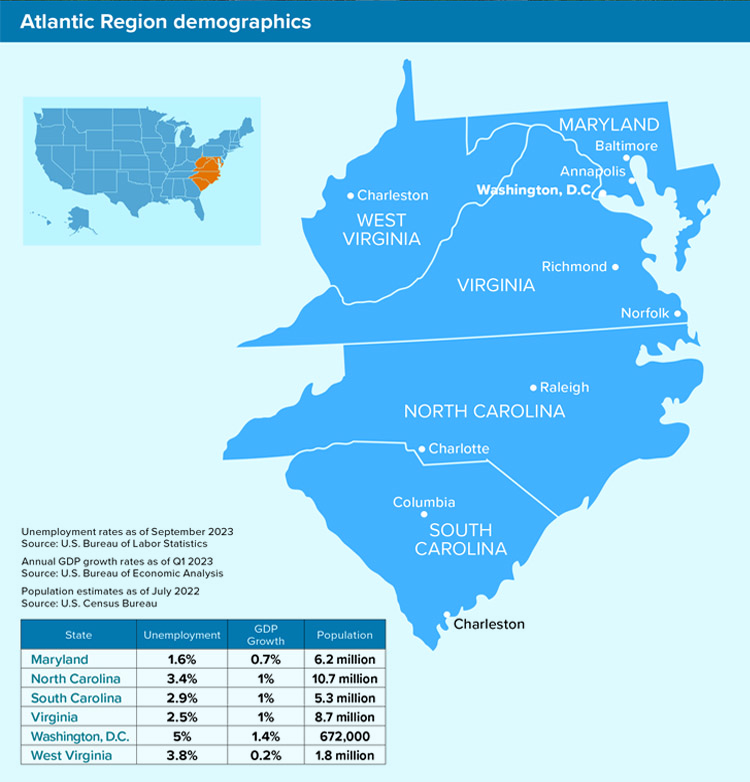
Maryland has a GDP of $480 billion. Like Virginia, the state’s proximity to the U.S. capital is a major influence on its economy. The Capital Region, which includes five counties closest to Washington, D.C., accounts for about half of Maryland’s GDP. Top economic sectors there include IT, telecommunications, aerospace, defense and biotechnology.
South Carolina has a GDP of $297.5 billion. Its largest employment sectors include trade, transportation and utilities; government; professional and business services; leisure and hospitality; and manufacturing. The Palmetto State is No. 1 in the nation for exported sales of tires and passenger cars. BMW, Mercedes Benz and Volvo are among the automakers with operations there.
The District of Columbia had a GDP of $165 billion last year. The main industries include the various aspects of the federal and local government. Professional, scientific and technical services combine with administrative positions to account for more than 40% of all employment. The technology, hospitality and tourism industries also are key economic drivers.
West Virginia has the smallest economy in the region with a GDP of $97 billion. But it continues to be one of the nation’s most important mining states through the production of coal and natural gas. ●
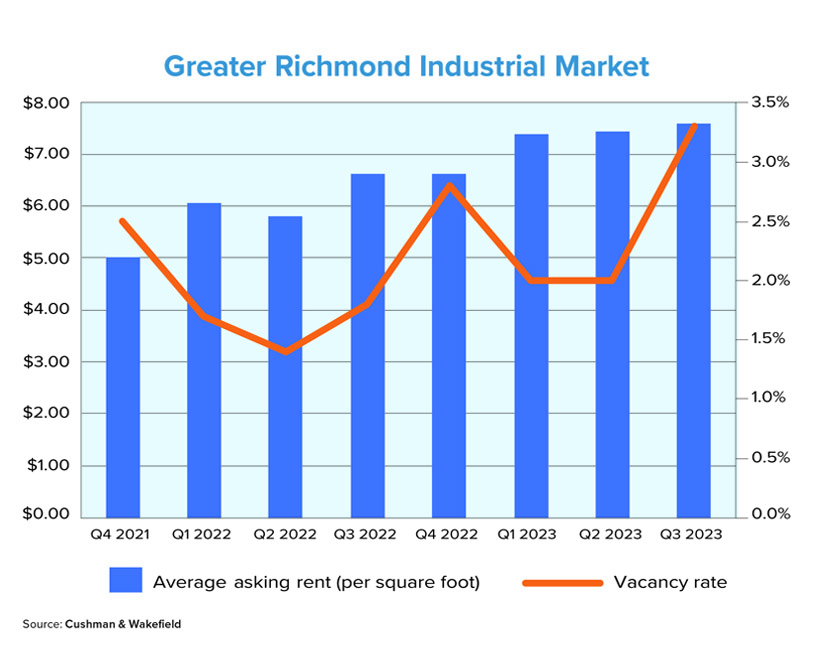
The Richmond area continues to be in growth mode, with total employment increasing by 4.2% during the year ending in third-quarter 2023, according to Cushman & Wakefield. Such growth has also influenced the industrial property sector, where more than 1 million square feet (msf) of new space was delivered in the quarter.
About two-thirds of this space wasn’t preleased, helping to push up the marketwide vacancy rate to 3.3%. Some of the projects that were added in Q3 2023 include a 400,000-square-foot block of sublease space and a 242,000-square-foot data center.
While industrial starts have slowed compared to prior years, Cushman & Wakefield reported that the city’s current project pipeline totals more than 4.6 msf, with about 84% of this total preleased. Such figures point to a strong industrial marketplace. Leasing activity in the third quarter topped 1 msf and exceeded 3.8 msf for the year. A strong fourth quarter was also expected.
Another sign of the sector’s strength is evident in rent growth, which rose an impressive 11.6% during the first nine months of the year and was 57% higher since the start of 2020. New leases and renewals for second-generation space are going for $8.50 to $9 per square foot, better than the marketwide asking rent of $7.60.
What the Locals Say
Raleigh is probably in a better position than most cities right now, in all honesty. The city has become a hotspot for people from all over the country, whether they are from the West Coast, the Northeast or even Florida. That attraction of new people has trickled down to the commercial space, so businesses in general are still growing here.
That means properties are still being sold and refinanced, but that isn’t true of all buildings. Like the rest of the country, there are some properties that are vacant and others where landlords are offering free rental space to make it appear that there are tenants. With that said, Raleigh is one place where things are still moving and lenders have yet to hit the pause button.
Industrial and multifamily properties are still doing well. Airbnb rentals are OK. They are still able to rent but they are not as strong as they were a year ago. Retail is doing OK in Raleigh as well. Where you see the most vacancies right now are in the office sector. Those properties are having a hard time filling up, probably because of the work-from-home movement.
As for 2024, we are expecting more of the same. We’re getting more calls from borrowers telling us that some lenders are no longer lending. I see that continuing. I think the number of lending sources is going to shrink. But there will still be some lending, which means the market isn’t going to freeze. That is very important. If the market freezes, everybody has a problem.

Partner
Hard Money Bankers
3 Cities to Watch
Annapolis
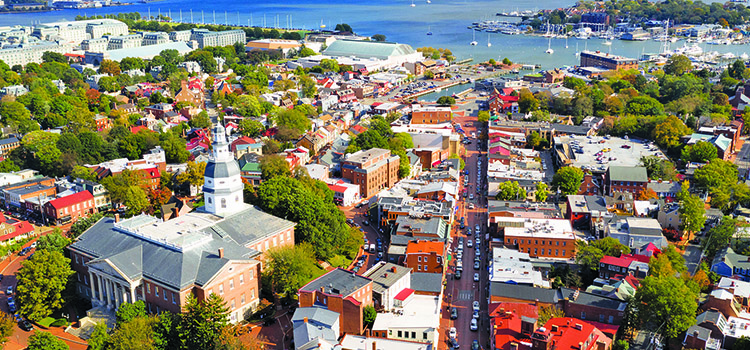
The state capital of Maryland is steeped in American history and boasts a strong tourism industry. The charming port city of 40,000 people is situated on Chesapeake Bay, and it’s known for its various boatyards and as the home to the U.S. Naval Academy. St. John’s College, with roots dating back to 1696, is also located in the city. State and federal government agencies are the region’s largest employers, but there’s also a thriving technology sector.
Raleigh
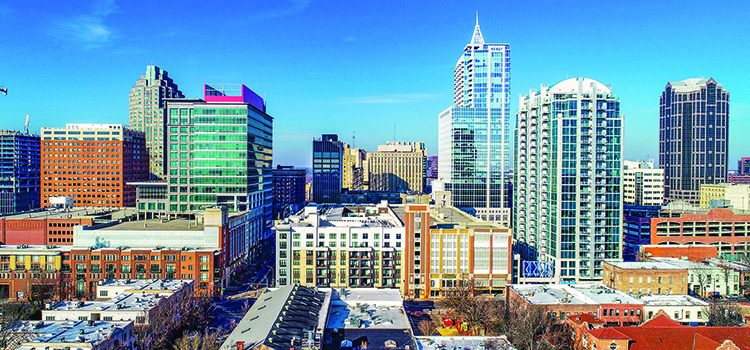
Often rated as having one of the nation’s best economies, this fast-growing North Carolina city of 477,000 residents is one of the nation’s leading technology and science research hubs. Nearby is the famed Research Triangle Park, a 7,000-acre innovation center that houses more than 375 companies, including science and tech firms, government agencies and startups. Raleigh is also home North Carolina State University and a variety of business incubators.
Charleston
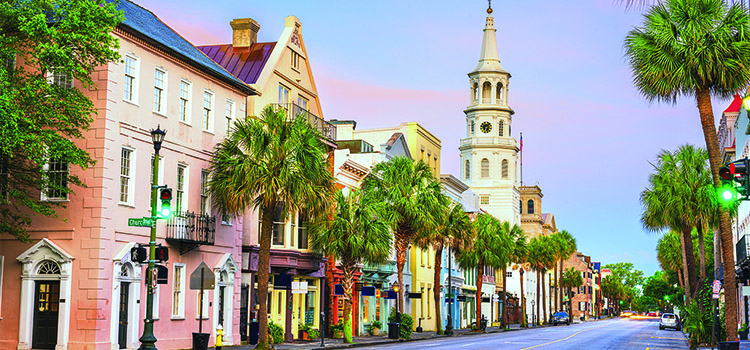
Founded in 1670, the South Carolina city of 153,000 people is a favorite with tourists who come for its beauty, history and Southern charm. This past April, The Wall Street Journal named Charleston as the sixth-best labor market in the country among small metro areas. The Port of Charleston, the deepest on the East Coast, is among the top 10 container ports in the U.S. The city is also home to Joint Base Charleston and a large Boeing operation.
Sources: Charleston.com, City-Data.com, City of Raleigh, Cushman & Wakefield, Data USA, Economic Development Partnership of North Carolina, Federal Reserve Bank of St. Louis, Maryland Daily Record, North Carolina State University, Research Triangle Park, St. John’s College, South Carolina Department of Commerce, South Carolina Ports Authority, Substack, The Wall Street Journal, Virginia Economic Development Partnership, Visit Annapolis, Visit Raleigh, Washington DC Economic Partnership, WFAE-FM, WJLA-TV, WorldAtlas.com






